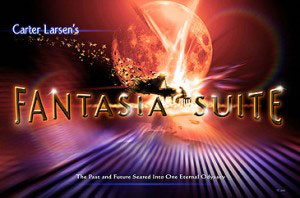by Dr. Ray A. Briggs, PhD
The musical compositions of Carter Larsen included in this volume embody the essence of great art, which is by nature transcendent. This level of art far exceeds barriers of status quo categorization and exists in an interstitial space all of its own. Fantasia Suite goes beyond numerous boundaries, including limitations of genre, chronological time, instrumentation, and a monolithic sense of cultural identity.

One axiom of great art is that it naturally evolves out of established tradition. Great artists are obviously impacted by those iconic individuals who preceded them in the field, but rather than simply emulate the stylistic characteristics of their mentors, these individuals find their own voices and thereby extend the tradition. Larsen is a composer of this ilk. While emulation demonstrates an important level of understanding of an art form, innovation occurs when the artist truly understands music on a deeper level. This requires not only the mastery of idiosyncratic skills, but also confidence in an ability to express significance and an absolute clarity of artistic vision.
Many of the pieces in Fantasia Suite draw from the best elements of Romantic musical style. For example, consider Reverence op. 36, which is reminiscent of Beethoven’s unique ability to craft the most beautiful, lyrical melodies and evoke a palpable, melancholic mood. Moreover, like Beethoven, Larsen utilizes the instrument in service of the music. When there are virtuosic passages in Larsen’s compositions, they appear as natural extensions of the music.
Fantasia Suite is composed for solo piano, and Larsen uses its myriad of sonorous capabilities (e.g., the breadth of timbre and nuance in Lumière op. 28) by writing music idiomatic to the instrument. However, Larsen’s music seems more appropriately defined as orchestral music played on the piano. The piano is simply the conduit through which the ideas are conveyed, but the instrument cannot fully contain the music. This quality is particularly evident in compositions like the Elegie op. 1, which could very well be expressed through the instrumentation of a full symphony orchestra.
Larsen’s compositions exude the feeling of being very much “in the now.” Perhaps this is due to the fact that many of the works developed from the composer’s own improvisations at the piano. Like jazz, this type of approach requires superior musical knowledge (theoretical, compositional, etc.), creativity, sensitivity, and above all fearlessness.
As evidence of Larsen’s adventurous approach to rhythm, experience the Latin-influenced Flight op. 7 with its lilting syncopation and additive sense of meter; or the Afro Cuban-like rhythmic interplay of Brunella op. 22.
Another commonality between jazz and Larsen’s work is an unmistakable and identifiable sound, one that invites and celebrates the individuality of the performer, yet simultaneously retains a certain level of artistic integrity and consistency. This uniqueness is most evident when others perform his works. As stated earlier, performers have the freedom to arrange each compositions in the order of their choosing. Larsen has honed in on the ability to create music that expresses his unique voice and allows for the individuality of the performer to be heard as well.
Ultimately, not even the best prose can capture the profundity of the musical journey presented here. Undoubtedly, the translation of the printed notes into actualized sound will uncover so much more than what I have attempted to describe in this text.
Dr. Ray A. Briggs, PhD